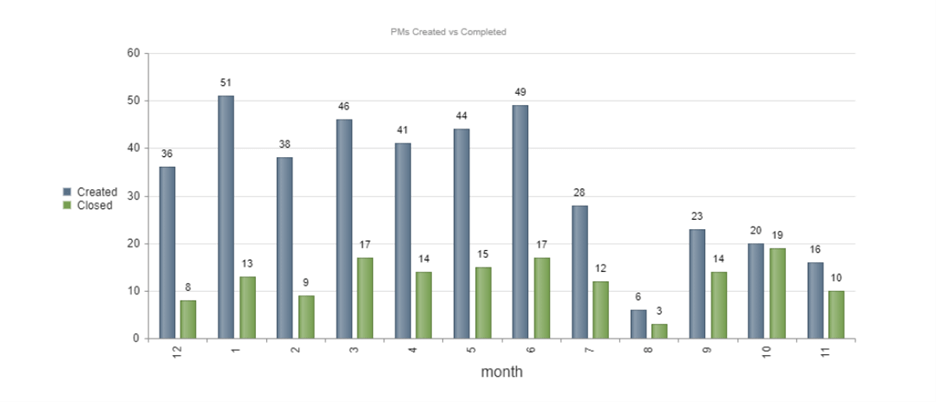 Maintenance metrics and Key Performance Indicators (KPIs) measure the performance of people, assets, projects, and more. They are essential to upholding the quality of maintenance at your organization, helping your company achieve its goals.
Maintenance metrics and Key Performance Indicators (KPIs) measure the performance of people, assets, projects, and more. They are essential to upholding the quality of maintenance at your organization, helping your company achieve its goals.
In the maintenance world, metrics are used to monitor things like machine failures, repair times, maintenance backlogs, and costs, and compare results to company goals.
Maintenance KPIs come in a few different categories, such as leading and lagging indicators.
Leading indicators are used to predict changes or trends that help enable future success. These include metrics like Preventive Maintenance (PM) compliance and estimated vs. actual performance.
Lagging indicators are used to measure past performance for comparison against goals. Maintenance metrics like Mean Time Between Failure (MTBF) and Mean Time to Repair (MTTR) are lagging indicators.
Prioritize these 7 Maintenance Metrics
The most successful organizations track a mix of both leading and lagging indicators. Some of the most important maintenance metrics to focus on include:
1. Mean Time Between Failure (MTBF)
Mean time between failures (MTBF) refers to the average time between breakdowns. This metric is used to analyze the equipment design and safety of complex assets. It is based on the ratio of operational hours to the number of failures. Organizations can optimize their Preventive Maintenance (PM) schedules by carefully tracking this KPI and associated performance metrics like uptime and downtime.
2. Mean Time to Repair (MTTR)
Knowing the average time needed to diagnose and repair equipment failures is vital when dealing with unplanned maintenance. This metric accounts for the time taken to cool down or resume production. MTTR can have a significant impact on the bottom line of an organization and can result in missed orders or business objectives.
3. Inventory Turnover
Inventory turnover represents the rate of inventory flowing through your storerooms or warehouses in a specified period of time. This metric calculates the cost of purchased stock vs. the cost of items on hand. Tracking inventory turnover helps you evaluate sales and ensure you can meet customer demand.
4. Planned vs. Unplanned Maintenance
Planned maintenance refers to any scheduled maintenance activity aimed at reducing downtime. Unplanned maintenance is any unexpected maintenance task, often the result of equipment failure. Tracking planned vs. unplanned maintenance helps you measure the success of your program.
5. Planned Maintenance Percentage
Knowing what fraction of all maintenance tasks are planned helps you identify inefficient processes. This maintenance metric is expressed as the percent of the total number of hours spent on planned tasks in a specified period. A value above 90% is considered “world class maintenance,” while a value over 70% is considered acceptable.
6. Preventive Maintenance (PM) Compliance
PM Compliance is the percentage of tasks that were completed according to schedule within a predetermined window of time. It’s another metric for evaluating a Preventive Maintenance (PM) program’s consistency and conserving resource usage. A good rule of thumb is that PM tasks should be completed within 10% of the scheduled maintenance interval. Monthly PMs should be completed within 3 days of the due date.
7. Overall Equipment Effectiveness (OEE)
This measure of how effectively your maintenance processes are running is the product of an asset’s performance, availability, and quality regarding how it operates at regular intervals. OEE provides an informed, data-driven picture of how efficient and effective your maintenance processes are. You want to shoot for a value of 100% to minimize item defects.
Leverage a CMMS to Track Your Maintenance Metrics
Simply put, maintenance performance metrics and KPIs help you track your organization’s success at meeting its goals, such as cutting costs or reducing downtime. And fortunately, modern software has made analyzing maintenance metrics and KPIs easier than ever before.
A Computerized Maintenance Management System (CMMS) like eMaint offers a customizable solution to tracking and analyzing your most important maintenance metrics.
With eMaint CMMS, organizations can set and measure a wide range of KPIs and maintenance metrics. The software lets you easily transform performance data into meaningful reports and dashboards, giving your organization both quantitative and qualitative insight into your maintenance strategy.
The most important information for meeting maintenance goals is different for every company, however, so it’s important to plan your maintenance approach from the top-down. Understanding how every aspect of your business will affect your team’s ability to reach its goals is vital.
Organizations that deploy CMMS solutions to track performance metrics experience visible improvements in many areas, including:
- Mean Time Between Failures (MTBF)
- Mean Time to Repair (MTTR)
- Planned Maintenance Percentage
- Preventive Maintenance (PM) Compliance
- Overall Equipment Effectiveness (OEE)
- Maintenance Backlog
- And More
eMaint gives you the ability to easily monitor your company’s most important maintenance metrics, increasing efficiency and equipment uptime throughout your work sites.

